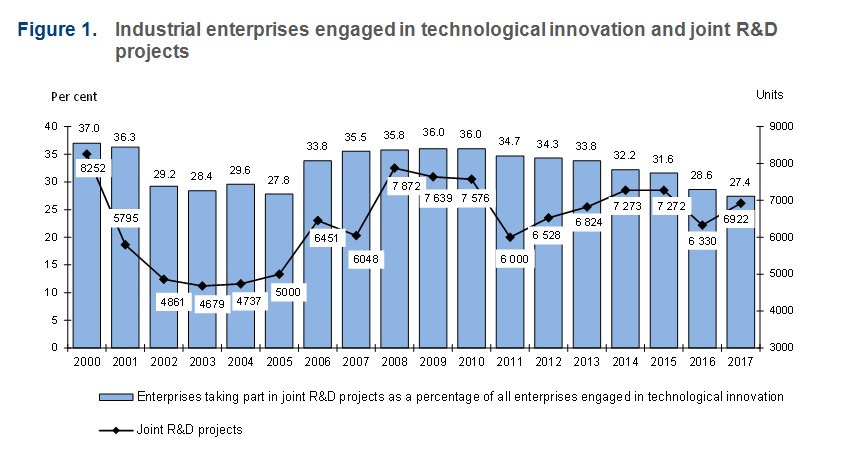Cooperation between Science and Industry
The HSE Institute for Statistical Studies and Economics of Knowledge analyses the dynamics and rate of industrial companies’ cooperation with R&D organisations.
In 2017, 790 industrial companies (3.3% of their total number) implemented joint projects with R&D organisations. Innovative companies that focus on manufacturing competitive products are primarily engaged in such cooperation. 27.4% of companies involved in the development and application of technological innovations took part in networking with R&D organisations. Companies that do not take part in innovation-related activities typically do not network either; their share in R&D cooperation is just 0.7%.
Over the past two decades the overall level of such cooperation tended to decrease: the share of innovative companies implementing joint projects with R&D organisations in 2000–2003 fell from 37% to 28.4%, and in 2005 to 27.8%; in 2006–2010, growth resumed to 36%, but then the figure started to gradually decline again (see Fig. 1).
In a ranking of European countries, Russia is in the middle, ahead of several nations with higher level of innovation development (such as Germany, Portugal, Italy, etc.). The leaders are Belgium (61.2% of companies), the UK (58.2%), and Estonia (56.1%).
When applying technological innovations in 2017, 6,900 R&D and innovation projects were implemented, some of them within the scope of state S&T programmes, federal targeted programmes, and international programmes (6,300 in 2016). The vast majority of such projects (more than 90%) were implemented internally; 3.5% in cooperation with EU Member States, 1.6% with the CIS countries, 0.9% with the US and Canada, and 0.8% with India and China.

The level of technological cooperation varied in different industries. Innovative high-tech companies were most open to external links, with 40.8% of them implementing joint R&D projects in 2017, while the corresponding figure was 44.3% for companies involved in the production of computers, electronic and optical products (see Fig. 2). In medium-technology industries, 35% and 36.3% of companies took part in network cooperation, respectively. In a number of industries, the corresponding figures were 1.5–2 times higher than the average, namely in metallurgy (59.8%), production of transport vehicles and equipment (53.1%), and coke and oil products (45.9%). In low-tech sectors, this indicator does not exceed 9.3%. In mining, about a third of companies are engaged in R&D cooperation (33%) (75% of coal production firms).

R&D organisations serve as important strategic partners for industrial companies when it comes to innovation development: 45.4% of such companies cooperated with them in 2017. In high-tech sectors the corresponding figure was 49.6%, in medium-technology ones — 41% and 51.4%, respectively, and in low-tech industries — 24.4%. In the mining industry, 63.6% companies had links with R&D organisations. Cooperation was particularly active with suppliers of equipment, raw materials, components, and software (40%), especially in low-tech industries (62.2% of innovative companies). A high level of cooperation was also noted among companies belonging to the same corporate groups as innovation developers (34.3%), and in high-tech sectors (40.3%). A third of companies (31.5%) involved universities in their innovation activities, and a quarter cooperated with consumers (26.9%). Contacts with consulting firms and competitors were mostly sporadic (11.3% and 7.4% of companies, respectively).
Cooperation links generally tend to be temporary in nature: in most cases technological cooperation was conducted in the scope of specific S&T and innovation projects (78% of organisations implemented such projects in 2017). Less than half (41.9%) of companies have long-term cooperation links with R&D organisations. 10% were engaged in one-off cooperation initiatives unrelated to specific projects.
Sources: HSE ISSEK calculations based on data from the Federal State Statistics Service; Eurostat; results of the project “Study of innovation process participants’ activities: development of theoretical framework and methodological approaches” carried within the scope of the HSE Basic Research Programme.
This HSE ISSEK material may be reproduced (copied) or distributed in full only subject to prior authorisation from HSE ISSEK (please contact issek@hse.ru). Parts (fragments) of this material may be quoted indicating the source and the author(s) and by providing an active hyperlink to the HSE ISSEK website. Any use of this material exceeding or violating the above conditions will constitute a copyright infringement.
